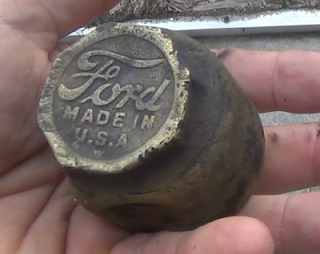Written by the TreasureGuide for the exclusive use of the Treasure Beaches Report.
 |
| Source: nhc.noaa.gov. |
Kate is expected to go north into the Atlantic. I don't see anything on the map that I expect to affect us much in the near future.
The surf is only one or two feet now, and the tides are about flat.
---
 |
| Embossed 1800s Bottle Find. |
This is a blown bottle from the late 1800s. Both sides are embossed.
 |
| Side Embossed CASTORIA. |
This product started as Dr. S. Pitcher’s Castoria , the formula being patented on May 18, 1868. Several years later the rights to that product and recipe was sold to Charles H. Fletcher, and marketed through the J. B. Rose Company, and later the Centaur Company.
The 17-year patent for the original Pitcher’s Castoria product expired on May 18, 1885. Several years after the patent expired, in 1896 the firm Heinsfurter & Daggett of Fargo, North Dakota began selling their own product under the name “Pitcher’s Castoria”. Centaur brought this to court, and in January 1897 the judgment went in favor of Heinsfurter & Daggett to sell their product as “Pitcher’s Castoria”.
(Meanwhile, probably sometime during the period of 1893-1897, bottles sold by Centaur changed from being marked “Dr. S. Pitcher’s”, to “Chas. H. Fletcher’s”.)
Here is that link.
Fletcher's Castoria / Pitcher's Castoria ~ Antique Glass Laxative Bottles (glassbottlemarks.com)
I'll be adding this bottle with better pictures to TGbottlebarn.blogspot.com.
---
Finding out when you are wrong is just as important as finding out that you were right. The reason some people find it so difficult to learn is because of their ego. They always want to think or show they were right so they spend a lot of time going through all kinds of mental gymnastics trying to prove they were right instead of correcting their mistakes.
I recently made these comments about the mystery item.
I can think of a few ways that the lead could get into the wood. It might have been pounded or pushed in, even though it seems unlikely that lead would be pounded in like a nail or something. It could have been poured into a drilled or hollow piece of wood, but I would imagine that would scorch or burn the wood unless there was some kind of treatment or procedure I'm not familiar with. Or perhaps the wood grew around the item.
Well I was wrong more than I was right. The good thing about that is I learned a few things.
 |
| Saturday's Mystery Find Once Again. |
I found numerous YouTube videos showing that you can pour molten lead into a wood mold and cause very little scorching.
Secondly, lead can be pounded into wood better than I thought. This sinker went into the end of this wood block very easily.
 |
| Sinker Pounded Into Wood Block. |
So I learned a couple of things, Unfortunately I am no closer to solving the puzzle of the mystery object, and it is looking like it will remain a mystery.
Here is what JamminJack said.
It looks like a very old shovel or tool when they would shove the metal up in a handle. Rolling and time in the sea may have made more funnel shape. A long time ago, I found something similar and about same size. The outer layer decayed when it was being restored. It is thought to be either an awl or punch. The metal was iron and believed part of the wrecks.
Jack sent along the following picture. |
| Sent by JamminJack. |
 |
| Spike in Wood. Photo by Alberto S. |











































